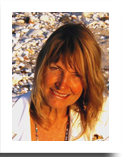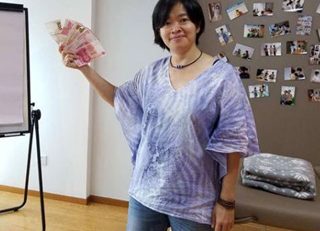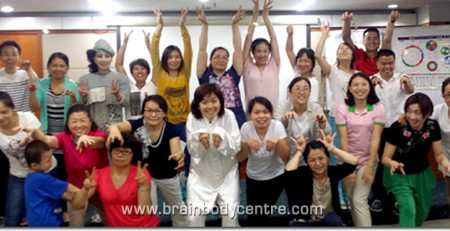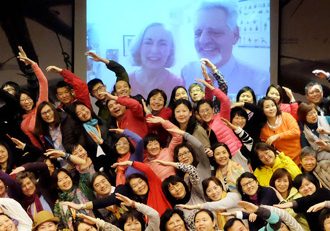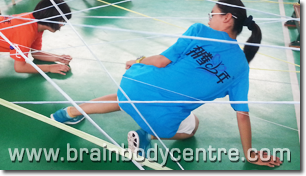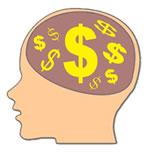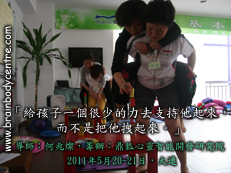The Actor Prepares: Mirroring in Role Play
by Amy Choi, Hong Kong, China,
at International Educational Kinesiology Conference,
July 2018, Damme, Germany.
“On the stage it is necessary to act, either inwardly or outwardly.”
– An Actor Prepares, Constantin Stanislavski1
SUMMARY
I discovered the use of “mirroring” accidentally when I worked with a client in a balance in September 2010. Since then, “mirroring” has become an interesting and useful way of balancing the others and myself. I discovered ways of observing the client by using receptive senses such as proprioception, hearing, seeing, touch, and intuition. There are also ways to express the client’s story through bodily movements, gestures, eye expressions, speeches and sounds. When used in the context of balancing, this way of expression of the body can be fully elaborated into art forms – mime, monologue, dialogue, multi-party drama, being some of them.
In Educational Kinesiology (Edu-K)’s 5-step balancing process, we use role play in pre and post activities in which noticing and measurement can be carried out and changes can be anchored.
This paper explores THE PROCESS of an effective mirror in the context of role play – how to allow the body to act and react to the flow in revealing the client’s stories by active non-doing (無為而為), and the necessary mental elements related to it.
~~~
THE ACTOR PREPARES
When seeing the term “role play”, one may naturally associate it to the performance of the actor on stage. The actor assumes a role, and then plays out its character in a plot.
I define the word “actor” literally, as the person who is in action. One does different actions in different roles. Take the case of the life of a woman for example, a woman whose role is a mother takes care of her child at home, while the same person who is a teacher will teach her students at work. In caring for a sick relative, she may become an hands-on healer. With her lover, she may reveal her sexy side like Marilyn Monroe. How to be effective in “role-playing” in many roles and in many contexts? My answer: One must be fully prepared, or ready, to do it!
WHY ROLE PLAY?
Role playing was developed by Jacob Moreno, a Romanian-American psychiatrist, and educator who was the founder of psycho-drama. He contended that people could gain more from acting out their problems than from talking about them. This method requires a protagonist (the client whose problems are being acted out); auxiliary egos (group members who assume the roles of other people in the protagonist’s life); an audience (other group members who observe and react to the drama); and a director (the therapist). The protagonist selects an event from his or her life and provides the information necessary for it to be reenacted. Although every detail of the event cannot be reproduced, the reenactment can be effective if it captures the essence of the original experience. The group members who serve as auxiliary egos impersonate significant people from the protagonist’s past or present, following the protagonist’s instructions as closely as possible. Techniques used in the reenactment may include role reversal, doubling, mirror technique, future projection, and dream work.2
Role playing is sometimes employed in other types of transformational techniques such as Edu-K. In Edu-K, role play is a process in the pre and post activity of the 5-step balance process in which noticing, measuring and anchoring can be carried out. In pre-activity, a relatively chaotic low gear-state is being re-created and noticed after setting the goal for the balance. Role play is then used in the post-activity, where a relatively integrated or high-gear state is being anchored after the learning menu.3 With the pre and post activity experiences, one will be able to be aware of the changes that have been created, and to allow new learning to be verbalized and applied at the conscious level.
WHERE THE BLEEP IS THE STAGE?
“There is nowhere the mind does not exist,”
Bruce Lee: The Artists of Life, Bruce Lee
“思想無處不在。”-《李小龍:生活的藝術家》李小龍4
The stage is the space where action takes place. To be prepared as an actor, one must know where the stage is. In the context of role-play in balance, I would define the “stage” as the space where the mind pays its attention. The mind creates the space where action takes place, and where transformation becomes possible.
In self-balances, the “stage” usually includes the awareness of ones own physical body. In a one-to-one balance, it is usually a circle of space that includes the client and the facilitator. In balances in class setting, it is usually the awareness of the space that includes the client, facilitator and the other participants. As the stage is set by the mind, its size and scope are flexible to the extent as to where the mind is able to set them. For example, for self-balance, the mind can extend the attention to a space that is much bigger or smaller than the size of ones physical body. For balances with others, it is the same. Thus, in a balance, the stage is a flexible space in which the actors mind are able to create and define.
“The stage is the space where the mind pays its attention.”
– Amy Choi
WHO ARE THE ACTORS?
Depending on what comes up in a balance, the actor(s) can be one or any of the following persons – in the context of a self-balance, it is usually the self (monologue). In one-to-one balance, it is usually the one who acts in the capacity of the facilitator and the person being balanced (dialogue and 2-person role play). In balance in class settings, it also may include the ones who volunteer to act in the role-play of the balance (conversations and multi-party story or drama).
Following the educational and self-responsibility approach, the actor would best volunteer to participate, thus not being appointed or forced into the role. By participating in the role-play, each actor knows that he/she has the capacity to put his/her attention into the common stage in which the story or drama is being co-created and unfolded together.
The audiences are not “actors”, and yet their minds are participating by watching as an observer, and by having subconscious or conscious reactions to the role-play. For instance, some audience may feel sympathy to the role-play and cry. Some may yawn. Some have thoughts or judgments projected. Thus, in one way or the other, the audience will also have an influence in what comes up in the story, though they are not the main actors.
In class-setting, I usually offer two other choices for the audience of the balance. The first one is the permission to fall asleep while watching the balance. I interpret this as the audience’s need to fall into sub-conscious learning mode or temporally choose “not to participate” consciously but perhaps subconsciously. Second is the choice of leaving the room where the balance takes place. It is usually for those who feel uncomfortable or unsafe watching a balance, and thus not wanting to see it or putting any of his/her attention onto the stage where the balance is being created.
MIRRORING IN ROLE PLAY – THE ACTOR PREPARES
In the mirroring process I use in balances, role play is sometimes being carried out at a semi-conscious and semi-sub-conscious level where the facilitator, auxiliary egos and sometimes the audience resonate in the unified field of the roles that are involved in the client’s story.
The “action” in mirroring originates half way in between doing and non-doing, being and observing. One waits for the tendency to move and then follow the flow of movement with trust. One relaxes the body, empties the mind, opens up the senses, observing internal and external processes, interacting while following the flow. Thoughts, emotions, and sensations may come. The actor’s job is to experience them all and reflect them all without judgment within safety level. Let the story unfolds and see what happens.
These are the words that are closest to describe the inner process of the Ming’s Mirror process:
My million hearts are one. 我萬心如一。
I come back to the present. 我回到現在。
I come back to here. 我回到這裡。
I come back to my centre and come back to my origin. 我守中歸元。
I open my field. 我開放場域。
I am clear and transparent. 我晶瑩通透。
I focus with my whole spirit. 我全神貫注。
I notice as is. 我如是覺察。
I experience as is. 我如是經歷。
I reflect as is. 我如是反映。
I trust the process. 我相信過程。
I create in the moment. 我即時創造。
I go back to the source. 我回歸本源。
I manifest my Self. 我呈現本我。5
The above are not procedures. Rather, they are attitudes and inner state of being that can be assumed by the actor in role play.
“All action in the theater must have an inner justification, be logical, coherent, and real.”
– An Actor Prepares, Constantin Stanislavski
CONCULSION: ENRICHMENT THROUGH MIRRORING IN ROLE-PLAY
“The heart of the Saint is peaceful and at ease.
It is the reflection for the Heaven and the Earth, and the mirror for every being.”
– The Natural Law of Heaven, Zhuangzi
“聖人之心靜乎,天地之鑑也,萬物之鏡也。《莊子:天道》
Through mirroring, being clear, transparent, peaceful and at ease, the actor so prepares his/her mind and body to be a natural and authentic reflection in role plays. Acting in non-doing, follow the flow, are the keys.
To be an effective mirror and to act in the role, one must have the proper internal state to be prepared to do it. One must be clear from past traumas and future expectations as much as possible; to go with the flow with every thought, emotion, feeling, movement direction or even pain, that may come up at the current moment. One has to be centered and focused. This is part of what I call authenticity.
Through mirroring, our life becomes not only that of ourselves but also a reflection of each other. One develops the ability to perceive reality in multi-perspectives. With this wider context, we may develop a better sense of who we are, and be more able to make life choices moment by moment, to live our life in our body, at our stage.
Role play allows the actor to gain the multi-sensory experience of the role, whether it is the proprioceptive sense of body movements, or the senses of sights, internal dialogue, external sounds, or touch. It is through role play in which the balance is enriched by multi-sensory and not just imagined, verbal or energetic experiences.
~~~
Other references:
Authentic Self Note Pad (Amy Choi’s collection of poems – often written after Ming’s Mirror experiences):
Chinese original: https://goo.gl/8TKLoy
English translation: https://goo.gl/heS9Fd
How to be a Good Kinesiology Practitioner, Speech by Carla Hannaford, Ph.D., at Japan World Kinesiology Conference, Kyoto, 11th October, 2011. (Dr. Hannaford talked about the explanation of the Ming’s Mirror after she has seen a demonstration.)
English Original: https://goo.gl/YCFVv7
German translation: https://goo.gl/R7UqLm
Japanese translation: https://goo.gl/2kFPak
Chinese translation: https://goo.gl/BaHS9D
Playing In the Unified Field, Raising and Becoming Conscious, Creative Human Beings by Carla Hannaford, Ph.D., Great River Books.
Energy Kinesiology Panel Discussion with Charles Krebs, Ph.D., James Oshman, Ph.D., Matthew Thie, Amy Choi, moderated by Juan Carlos. 2012 International Kinesiology Conference in Spain (with English and Chinese subtitles): https://www.youtube.com/watch?v=KJ5pQkDQ_fI
About Amy Choi Wai Ming
Amy Choi has been a Touch for Health and Brain Gym Instructor since 1998. She discovered the Ming’s Mirror Method 明鏡調和法 in 2010 and has been using it as a tool to work with her clients in one-on-one and class setting in her Authentic Self Workshop Series of Qinesiology in China and Japan since. Amy’s centre’s website: www.brainbodycentre.com
Email: info@brainbodycentre.com.
1) P. 39, An Actor Prepares, by Constantin Stanislaviski, Routledge, 1989
2) https://en.wikipedia.org/wiki/Jacob_L._Moreno
3) Brain Gym 101 – Balance for Daily Life, Paul and Gail Dennison, Edu-K Inc.
4) p. 30李小龍 《李小龍:生活的藝術家》2010. Bruce Lee: Artist of Life by Bruce Lee, Joint Publishing Hong Kong Ltd.
5) Introduction to the Ming’s Mirror Method, Amy Choi, International Kinesiology Conference Manual, IAK, Germany, October, 2017


